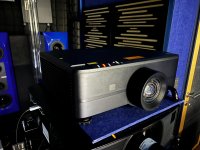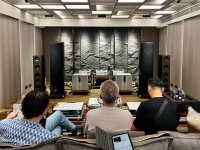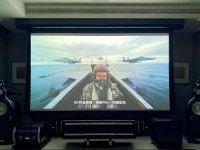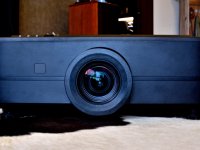|
|

樓主 |
發表於 2008-2-4 14:42:20
|
顯示全部樓層
3.Indifocus 售價400元美金 五星評比:兩顆
 The IndiFocus that we tested initially arrived equipped with a proprietary focus gear that only interfaces with IndiFocus lens gears. For standard 0.8/32 pitch lens gears you’ll need the $20 Cine-Pitch gear option, which is what we conducted our tests with. The IndiFocus that we tested initially arrived equipped with a proprietary focus gear that only interfaces with IndiFocus lens gears. For standard 0.8/32 pitch lens gears you’ll need the $20 Cine-Pitch gear option, which is what we conducted our tests with.
The follow focus attaches to standard 15mm rods and locks in place with a single knob. A center knob underneath locks the horizontal slide. You can fully loosen that knob and quickly re-mount the follow focus on the opposing side of the camera without unlocking the base from the rods. Fit and finish is lacking somewhat; for example, the base that mounts to the rods is floppy when loosened. You tend to fumble around for a bit when first mounting the unit. There is also a vertical riser adjustment that, unfortunately, tends to flex forward and back under load. Exacerbating that issue is the fact that the face of the focus gear is very narrow. The end result is that the focus gear tends to pop off your lens gear if you happen to be using a lens with some forward travel in it. Flexing is nearly eliminated by dropping the unit to its lowest setting, which of course negates the usefulness of the vertical adjustment option.
We noted quite a bit of slop in the gearbox, measuring between 6.5mm and 7.5mm of play inherent in the unit. Gears can be replaced with other optional pitch ratios. This unit also exhibits the tendency to draw focus and lens gears towards each other as you lock the unit down. Leaving extra space between the gears as you mesh them solves this behavior.
The white marking ring is not removable, and the metal marking indicator is fixed in place. The focus dial is a grooved hard plastic design with a solid grip surface, and the face of the dial features a proprietary accessory port that only fits the IndiFocus whip. We noted that the extension whip does not lock into the port—instead, it uses a weak magnet to stay connected.
The IndiFocus whip, employing a spring-like design, tends to store up and then release tension as you focus, making repeatable movements difficult. Another issue we noted was the use of disparate fasteners throughout the design. For instance, the focus gear is attached using a metric Allen head screw, while the vertical riser uses an SAE standard Allen head. While it may seem that we’re picking at straws, non-uniform fasteners realistically means you’ll have extra tools to remember in the field.
In conclusion, the IndiFocus is a basic follow focus that performs acceptably in certain specific configurations, obviously considering the price point. However, there are a number of concerns we noted in use with our 35mm adapter system, and the design in general is not very robust. While it may well fit the needs of many shooters, we would not recommend the IndiFocus for use in a professional production environment.
4.Petroff Mini 售價900元美金 五星評比:四顆

The Petroff Mini is a solid and reliable performer. The unit attaches to standard 15mm rods and locks in place with a side-mounted knob that controls horizontal slide. The gearbox is not dampened, but gear action is noiseless and buttery smooth. Using our millimeter marking scale, we found that this unit measured between 1mm and 1.5mm of play inherent in the gearbox.
The standard 0.8/32 pitch focus gear can be mounted on the opposite side of the gearbox, and gears can quickly be replaced with optional pitch ratios. We noticed that when meshing the focus and lens gears the lock knob tended to pull the unit in towards the lens, binding it up and stressing the lens mount. Leaving a little extra space between the gears before we locked it down alleviated that concern. Another issue we noted was that the fixed marking ring is molded in one piece with the focus dial, and is a medium gray color. Black grease marks do not stand out on the gray, so you’ll need to use a white marker for this unit. The marker surface is a very useful design, slanted at an angle that can be easily read by both the focus puller and the camera operator. A rotating metal marking indicator can be positioned anywhere around the marking ring with a quick adjustment knob. The focus dial has a nubby rubberized texture that provides plenty of friction for hard pulls, and the face of the dial features a standard accessory port for extension whips or a speed crank.
Overall, the Petroff Mini offers good fit and finish, and is equally at home driving 35mm cinema PL and 35mm still lenses. A quick note: Petroff calls this unit the “Economy” model. For a few hundred dollars more, the company sells a similar unit that features a replaceable white marking ring. (Thanks to Petroff authorized reseller Ste-Man, Inc., for providing our review demo unit.)
5.Redrock Micro 售價650元美金 五星評比:四顆

Redrock Micro’s follow focus attaches to standard 15mm rods and locks in place with two side-mounted knobs. A center knob underneath locks horizontal slide. You can fully unscrew that knob and quickly mount the follow focus on the opposing side of the camera without unlocking the unit’s base from your rods. The gearbox is dampened, making focus pulls smooth and noiseless.
Testing the unit with a millimeter marking scale, we found very little slop in the gearbox, measuring between 1.5mm and 2mm of play inherent in the gears. The extra-wide 0.8/32 pitch focus gear is fixed to one side of the gearbox, which may be a concern during use with some unique rig configurations. Gears can be replaced with optional pitch ratios. The focus gear and lens gear tend to tighten towards each other as you lock the unit down—leaving extra space between the gears when you mesh them solves that issue. The removable white marking ring secures quickly and solidly in place with a magnet. The metal marking indicator is fixed and cannot be repositioned.
The focus dial features a metal surface with hundreds of machined grooves, offering plenty of grip for complicated pulls. The face of the dial features a standard accessory port for extension whips or a speed crank. Redrock includes three wide plastic lens gears in the basic follow focus bundle, each of which employs a simple toolless design that works well with a wide variety of 35mm still camera lenses.
We found the Redrock Micro follow focus to be a reliable performer and solidly constructed. As you would expect from a company that makes lens adapter systems, it handles cinema and still lenses on a 35mm adapter with ease. While it doesn’t offer as many features as some other units we’ve tested, the minimal amount of gear play at this price point was most impressive. We believe this particular unit offers the best combination of features and performance for your dollar.
Arkansas-based filmmaker Matthew Jeppsen is founder of the online production info resource FreshDV (www.freshdv.com), and a contributing partner with cineastfilms, an international wedding cinematography production company. Kendal Miller (www.impstudios.com) is an award-winning director of photography located in the Chicago area, and a contributing editor at FreshDV.
[ 本帖最後由 tmtcman 於 2008-2-4 14:44 編輯 ] |
|




